When it comes to search engine optimization (SEO), you’ve probably heard plenty about keyword research, compelling headlines, and overall content optimization. But do you know how to write meta descriptions that will boost your click rates and drive more traffic to your site?
As a content writer at OptinMonster, I write and edit meta descriptions every day. I work to optimize each blog post’s description so it encourages more search users to click. In order to succeed, I apply my 17 years of professional copywriting experience, as well as thorough analysis of meta description examples from top-ranking brands.
In this post, I’ll share 5 effective meta description examples and my top 8 tips for writing a good meta description. But first, let’s talk about what exactly a meta description is and why it matters.
- What Is a Meta Description?
- Why Are Meta Descriptions Important? (4 Top Benefits)
- 5 Meta Description Examples & Why They Work
- How to Write Meta Descriptions to Drive More Clicks (8 Tips)
- FAQs
What Is a Meta Description?
A meta description is a short snippet of text placed inside a webpage’s code to describe its content. That description may appear under the page’s URL in search results, and it should describe the page’s content and encourage users to click.
Here’s an example of the meta description we wrote for our own homepage. As you can see, Google uses it in our search listing:

The meta description will also appear when pages and posts are shared across other websites and social media platforms, although the real estate given to the description does vary:
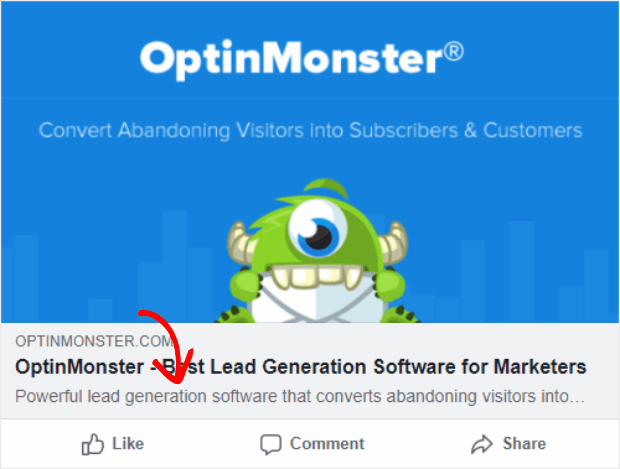
How to Add a Meta Description (With Code or a WordPress Plugin)
Adding a meta description to your site is easy and requires minimal HTML editing. Simply add this meta description tag code between the <head> </head> tags on the page:
<meta name="description" content="Here is my meta description that will show up under my URL in search results.">
If you use an SEO plugin like All in One SEO (AIOSEO), adding meta descriptions is even easier. When you’re editing a post or page, you’ll see the All in One SEO settings section below the WordPress text editor.
Just click inside the Meta Description field and enter your description.

AIOSEO automatically tracks the character count of your meta description. I’ll talk about the importance of character count a little later.
You’ll also see a preview of what your search engine result will look like if Google uses your description:

Whether you use code or a plugin, it only takes a couple of minutes to add a meta description to any webpage on your site.
Why Are Meta Descriptions Important? (4 Top Benefits)
According to a study from Ahrefs, nearly 75% of top-ranking pages include a meta description. Why do so many successful websites go to the trouble of writing meta descriptions for every page on their site? Because they work!
Here are a few of the benefits of writing high-quality meta descriptions:
1. Increased Click-Through Rates (CTR)
A well-crafted meta description can entice users to click on your link instead of others.
Your meta description works with your title and URL in your search result to show users that it’s YOUR page that will have the answer to their problem. When you have an eye-catching title, a straightforward URL, and a compelling meta description, your click-through rate is going to increase.
2. Indirect SEO Benefits
Here’s an important truth: meta descriptions don’t play a direct role in your search rankings.
However, a high CTR signals to search engines that your webpage provides the information that searchers are looking for. When your meta description increases your CTR, that higher CTR will likely improve your search rankings over time.
3. Enhanced User Experience & Engagement
Meta descriptions provide a concise summary of your page’s content, helping users quickly determine if the page meets their needs. When website visitors discover that your page has exactly what they were searching for, you’ll see reduced bounce rates. You’re also likely to see an increase in the average time spent on your website.
Similar to your CTR, these metrics can also gradually improve your website’s search performance.
4. Improve Social Sharing Performance
Meta descriptions also display on shared links on many social media platforms. Here’s an example of a link shared by WPForms on their Facebook page:
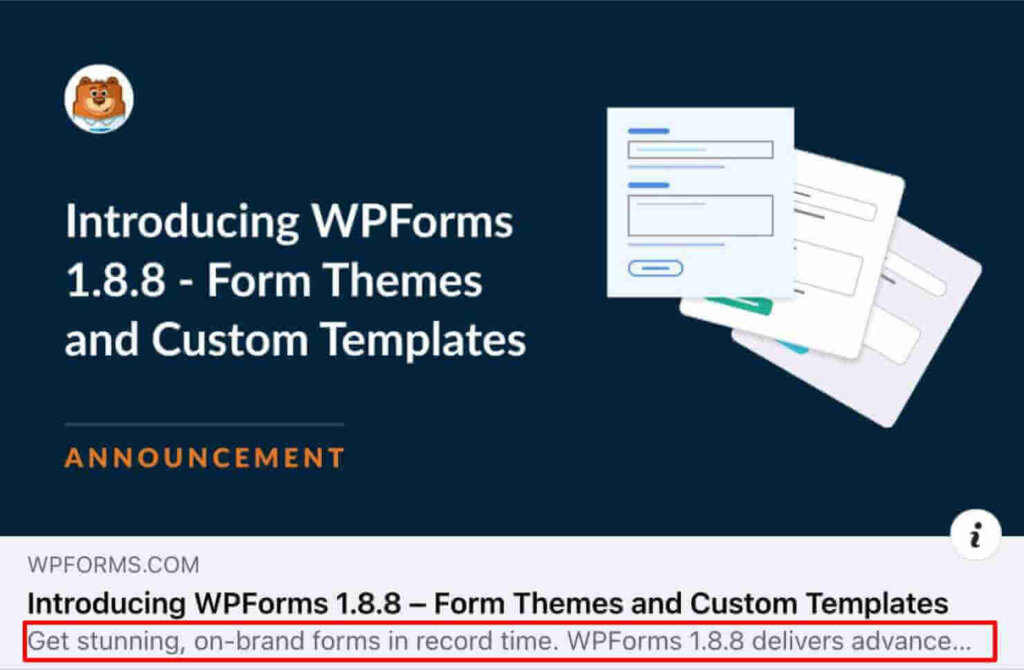
Even though Facebook cut off the end of the meta description, it still provides valuable extra information for readers. When you add meta descriptions to your pages, you gain more control over how your links display on social media, regardless of who shares them.
Considerations on Meta Descriptions
The benefits of meta descriptions are undeniable, but keep in mind that they have limitations.
First, as I mentioned earlier, meta descriptions do not directly affect search rankings, so any improvement to your SEO will happen slowly through improved metrics.
Second, Google does not always display your meta description in your search listing. It often creates its own snippet from the page’s content, based on what the algorithm thinks will be most helpful for searchers. This can be extremely frustrating, especially when you believe you’ve crafted the perfect page description.
However, optimized meta descriptions are still crucial. When they are displayed, they can significantly enhance your click-through rates, driving more traffic to your site. Even if Google doesn’t always use your meta description, having one increases the chances of attracting and engaging your audience.
5 Meta Description Examples & Why They Work
Next, I’ll share some meta description examples from high-ranking websites. For each one, I’ll discuss why it attracts more users to click. These examples all show Google search results, but the benefits would apply on social media as well.
1. WPBeginner’s Review of OptinMonster
I keep an eye on search results for “OptinMonster” so I can understand what potential customers see when they search for our software. Here is the Google SERP (search engine results page) listing for WPBeginner’s review of OptinMonster:

Why this meta description example works: WPBeginner provides a lot of info in these 153 characters, and it’s exactly the information that people searching for “OptinMonster” or “OptinMonster review” want to know. The meta description tells searchers that OptinMonster is the best plugin of its kind, and it gives an overview of key features. That’s a great enticement to click into the review to learn more details.
2. Blog Post from Grants Plus
I got this search result when Googling “how to write a grant.” It’s a blog post from Grants Plus that provides a beginner’s guide to nonprofit grant writing.

Why this meta description example works: Grants Plus tells users exactly what to expect if they click. They’ll get a “crash course” on grant writing that answers questions and provides tips. This description lets beginners know that this blog post will be a great place to start. Similarly, experienced grant writers will understand that a crash course may not be what they’re looking for.
3. Express’s Summer Dress Collection
For an eCommerce meta description example, I did a Google search for “best summer dresses.” I saw this result from the clothing store Express. Specifically, it’s a link to their summer dress collection:

Why this meta description example works: Express’s description is full of evocative language: “cute,” “flowy,” “floral,” and “perfect for any occasion.” Plus, it lets you know exactly what you’ll get to do if you click the link: Shop!
4. OptinMonster’s Smart Success Feature Documentation
Here’s another example of a meta description we use at OptinMonster. If someone searches “OptinMonster Smart Success,” the first result is our documentation on how to use that feature:

Why this meta description example works: Meta descriptions should be tailored to the page’s intended audience and purpose This page is a straight-forward tutorial on using one of our features, and it’s geared toward current customers. Therefore, the meta description simply explains what this page will show you how to do. No frills are needed!
5. Chairish’s Midcentury Modern Furniture Listings
I found this search result from Chairish when I Googled “used midcentury modern furniture.” Chairish is a curated online marketplace for high-end vintage products, and this link leads to their category page for midcentury modern furniture.

Why this meta description example works: Like the earlier example from Express, this description begins with a call to action to shop for the products the user is searching for. Chairish offers more enticement by citing its “thousands of unique items” and letting shoppers know up front that they can make offers.
How to Write Meta Descriptions to Drive More Clicks (8 Tips)
It’s not easy to write a meta description that is compelling enough to grab attention and get click-throughs. However, there are some essential guidelines that can help you succeed.
Here are my top 8 tips to help you learn how to write a good meta description that will persuade more users to visit your website.
1. Keep It Under 160 Characters
Aim to keep your meta description length between 150 and 160 characters. This length ensures your description is concise yet informative. It also fits within the space provided by search engines without getting truncated.
Plugins like AIOSEO track the character count as you type, making it easy to manage your description length.
2. Include Keywords
Even though Google doesn’t use meta descriptions for ranking, you should still include SEO keywords to show your page’s relevancy. Your keywords should be used naturally and give searchers an idea of what your page is about.
Plus, Google will often put important keywords in bold, which can help draw attention as the user scrolls:

3. Include a Call to Action
Think of your meta description as an ad for your page or post, complete with its own call to action (CTA).
In their meta description for their home page, Help Scout includes a CTA encouraging users to “get started for free.”

Check out our guide to crafting the perfect call to action for best practices and examples.
4. Identify High-Priority Pages
What if you already have a website with a ton of pages, and none of them have meta descriptions? Your first step is to identify the pages that will benefit most from adding a description. Here are some ideas of where you should start:
- Homepage: Your homepage should always have a meta description. This site description is your chance to give the first impression of your brand.
- High-Traffic Content: If you have pages that are already getting a lot of search traffic, make sure that they have accurate and appealing meta descriptions so you can keep up your SEO momentum.
- Product & Category Pages: Your product and category pages often drive your commercial organic traffic. Make sure these pages have engaging meta descriptions that appeal to your target customer.
- Pages Without Much Text: Pages with heavy video or image content can be incredibly valuable. However, they won’t have enough text for Google to pull its own description. These pages will need a meta description to display well in search.
For an example of a page without much text, here’s a view of OptinMonster’s exit-intent gallery:
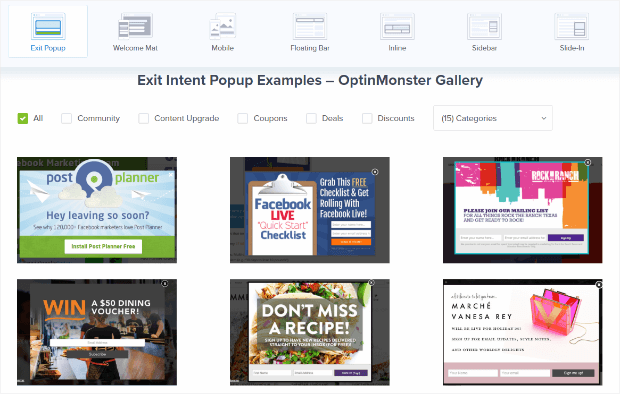
And here’s what the written meta description looks like:

If we hadn’t added this description, Google wouldn’t have had any useful text to include in the search listing.
5. Add Emotional Triggers
Your meta description is an opportunity to stand out and capture attention. Use words that evoke curiosity, excitement, urgency, or other emotions relevant to your content.
Want some examples? Check out these resources:
- 700+ Power Words: The Secret Sauce of Successful Copy Revealed!
- Urgency Words: 14 Ways to Use Them to Boost Conversions
6. Make the First Few Words Count
I showed you earlier that social media often heavily truncates meta descriptions:

In this case, Facebook only shows the first 76 characters of the description. Thankfully, WPForms made those characters count by explaining exactly what’s on offer in the first 7 words.
7. Align with Search Intent
Make sure your meta descriptions match what users are looking for when they search. Think about their needs and craft descriptions that highlight how your content can help.
For example, let’s say you’re targeting the search query “easy dinner recipes.” Your meta description could use phrases like “ready in 30 minutes” or “with just a few ingredients.” This way, your descriptions feel more relevant and inviting, making users more likely to click on your link and find exactly what they need.
8. Consider Using AI to Help
Sometimes, short pieces of writing cause the worst writer’s block. If you’re struggling to perfect your meta descriptions, an LLM (large language model) tool like ChatGPT or Google Gemini might be able to help. You can feed it the page’s content and ask it to create 5 potential meta descriptions. Alternatively, you can feed it your current description and ask for tips to improve it.
Either way, keep these considerations in mind:
- You know best: An AI tool won’t understand your website, content, brand, audience, or goals like you do. You’ll almost certainly need to edit any description it gives you.
- AI can be repetitive: LLMs are notorious for relying too much on specific words and phrases, such as “unlock the secrets.” Avoid taking these suggestions if you want a unique description that doesn’t sound like AI.
- AI is bad at counting: LLMs are unable to count characters accurately, so don’t depend on them to hit the correct character range.
As with most uses for LLMs, these tools can help speed up and improve your meta description writing. However, they don’t replace the knowledge and expertise of an experienced copywriter.
Meta Description FAQs
1. What information is in a meta description?
A meta description includes a brief summary of a webpage’s content, its benefits for the reader, and often a call to action. It should be clear, concise, and compelling. A meta description is typically 150-160 characters long.
2. Are meta descriptions important for SEO?
Yes, meta descriptions are important for SEO because they can improve click-through rates (CTR) from search engine results pages (SERPs). While they don’t directly impact search rankings, a well-written meta description can attract more visitors to your site.
3. Can Google change my meta description?
Yes, Google can change your meta description. If it determines that your description is not relevant to the search query, it might display a snippet from your page content that better matches the user’s intent.
4. How do I know if my meta description is effective?
You can track the effectiveness of your meta descriptions by monitoring your click-through rates (CTR) in tools like Google Search Console. A high CTR indicates that your meta description is compelling and relevant to search queries.
5. How often should I update meta descriptions?
You should update meta descriptions whenever you make significant changes to your content. Additionally, periodically review and revise them to ensure they remain relevant and effective in driving clicks.
Attract More Visitors . . . & Convert Them Into Customers!
Now, you have all you need to create your own high-converting meta descriptions to boost your CTR, improve your content marketing, and drive more traffic to your website.
Want to learn more SEO tips? Check out these resources:
- Beginner’s SEO Guide: Learn the Basics & Most Important Tips
- 10 Powerful SEO Ranking Factors
- On-Page SEO Checklist: How to Fully Optimize Your Posts
- What Is Off-Page SEO? 15 Proven Tips to Boost Rankings
After you’ve driven all this new traffic to your website, your next goal is to convert those visitors into subscribers and customers.
The best tool for that is OptinMonster! Optinmonster is the #1 lead generation software on the market, and you can use stunning popups, floating bars, and other onsite campaigns to show your most enticing offers to the right people at the right time.

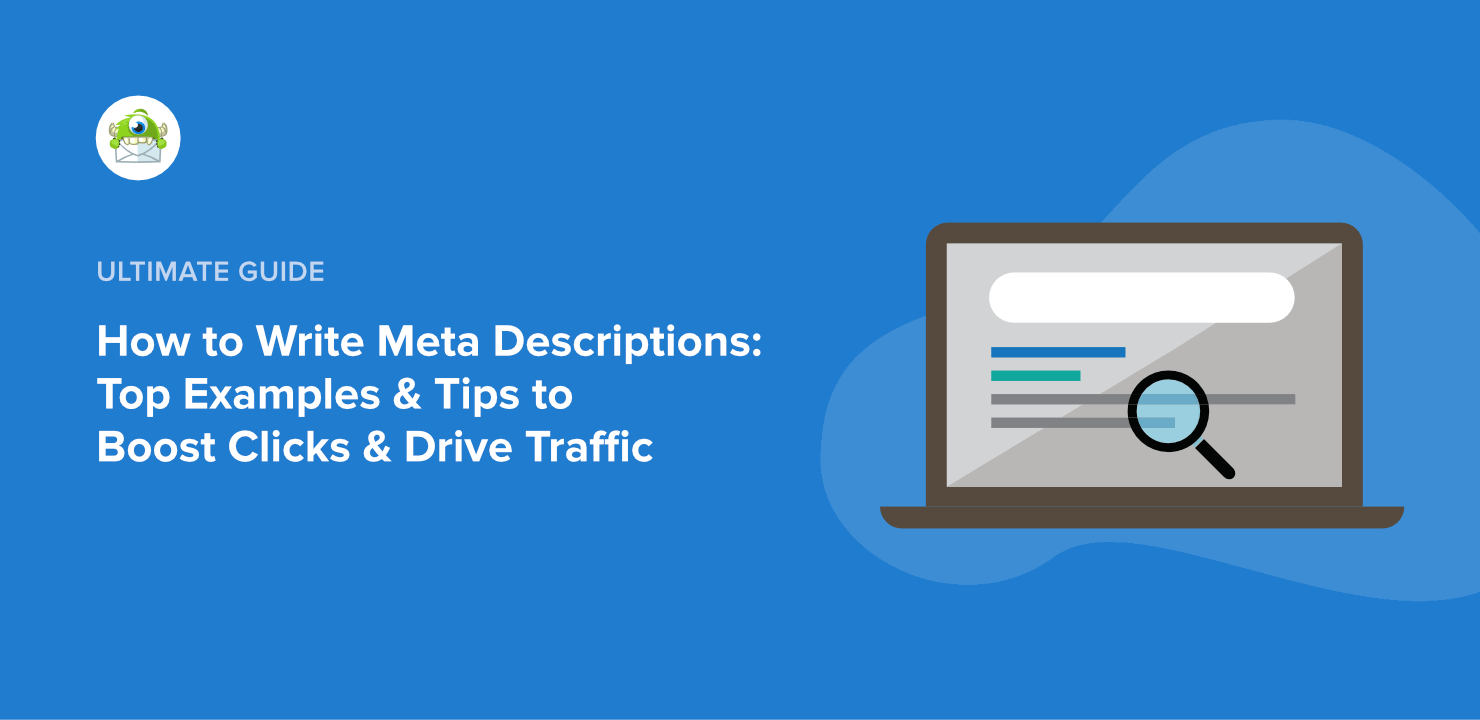
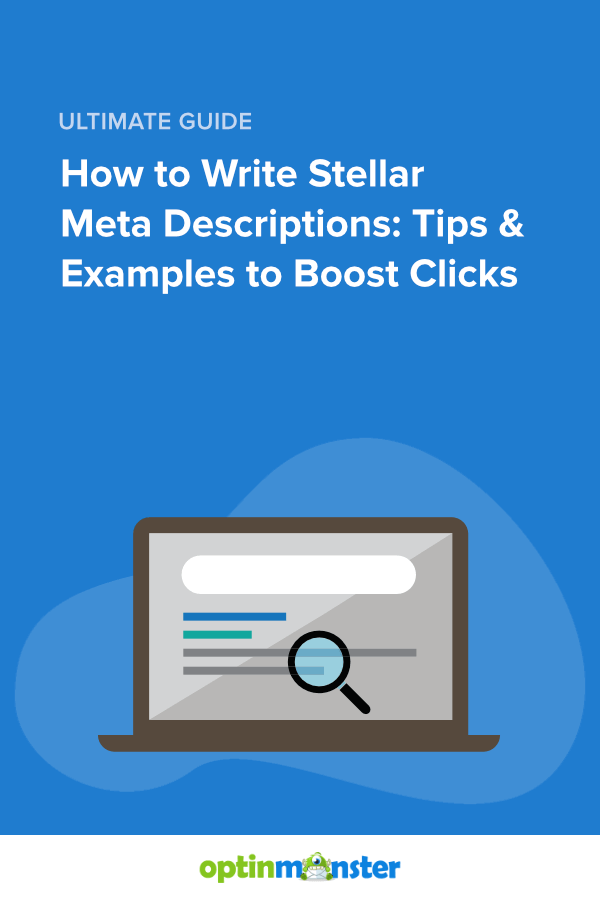








Add a Comment